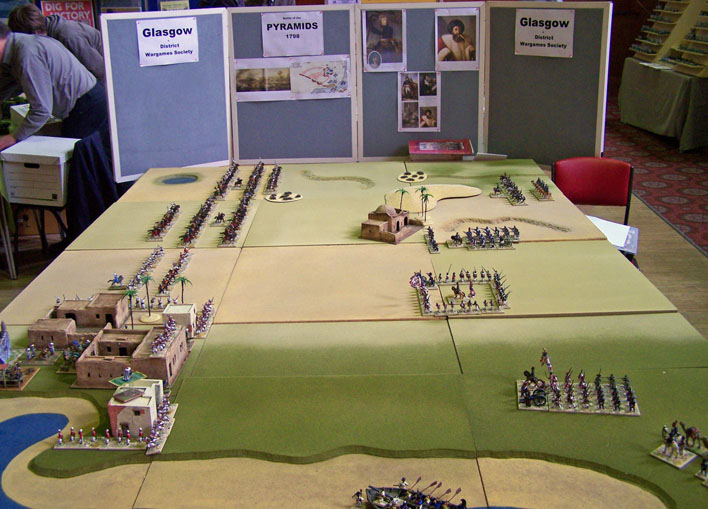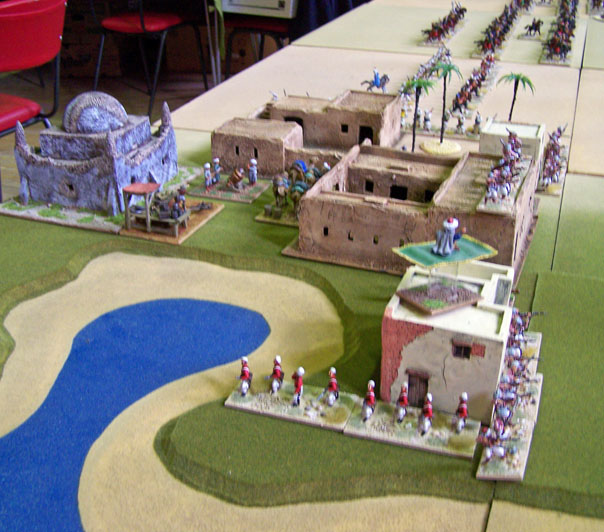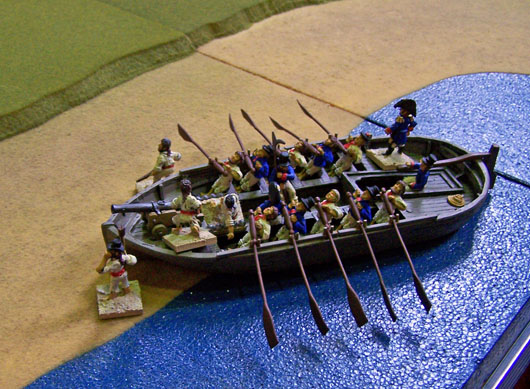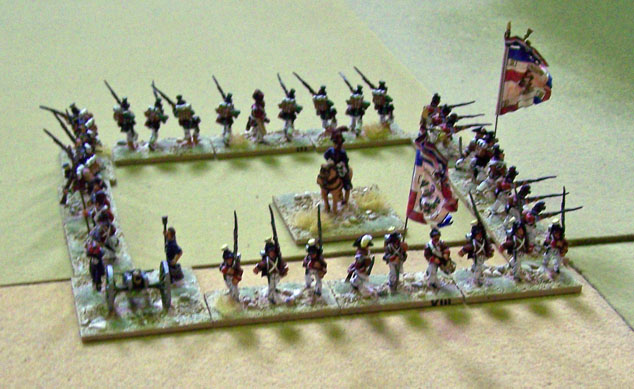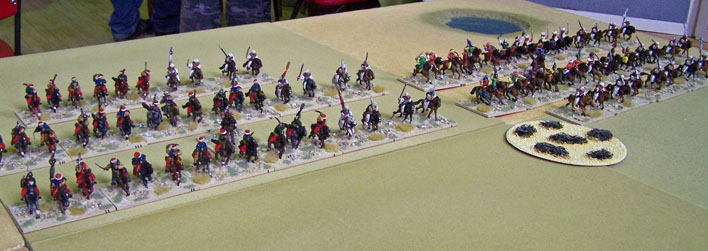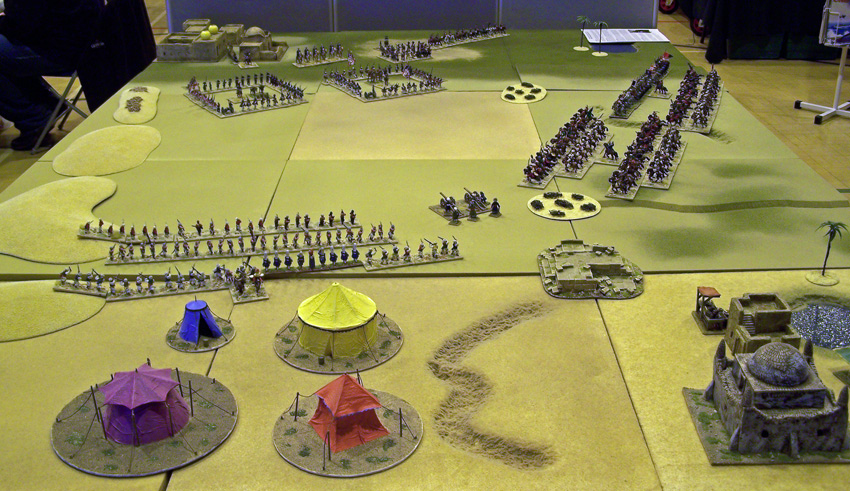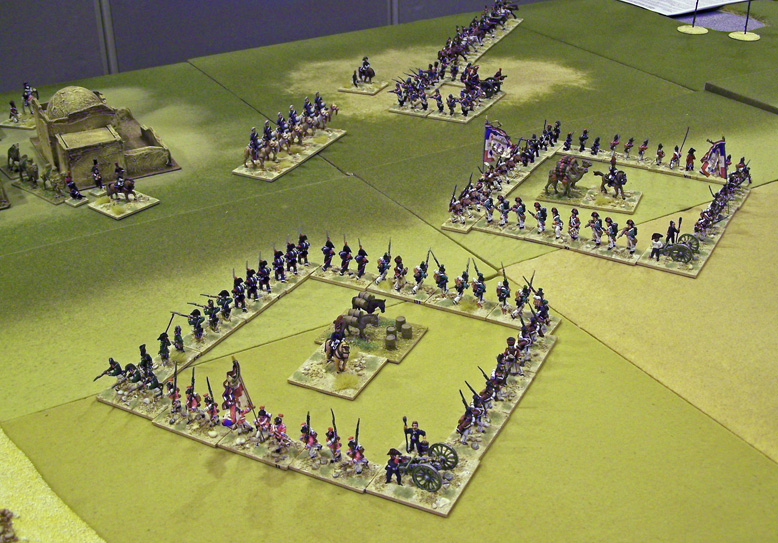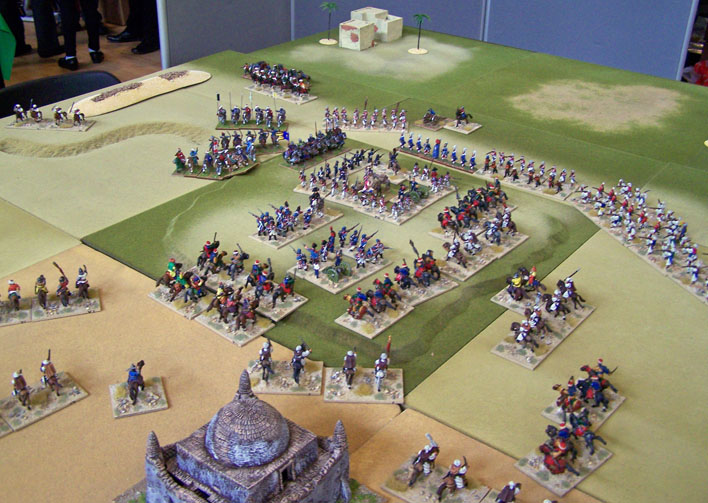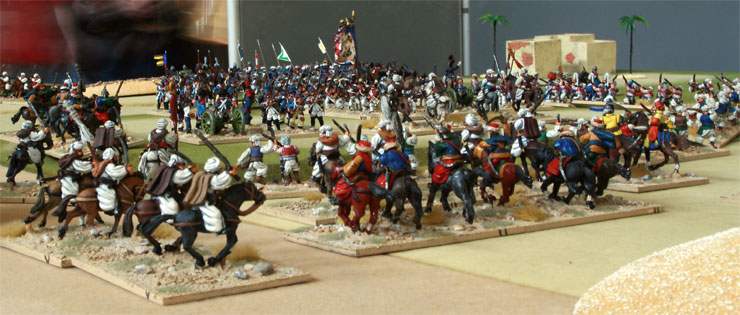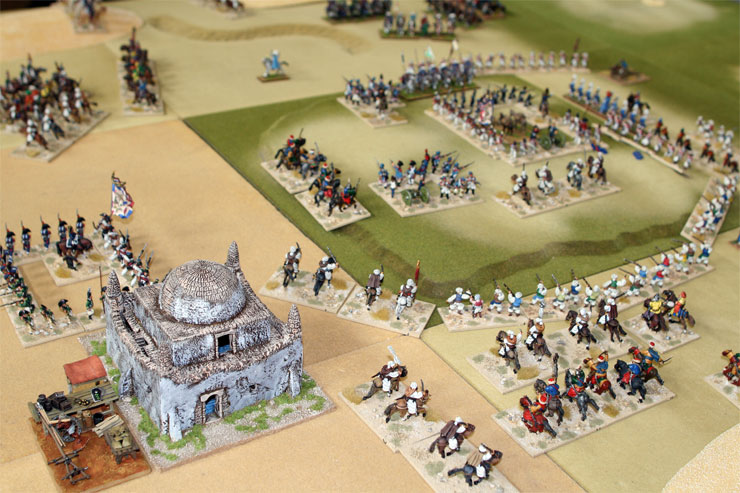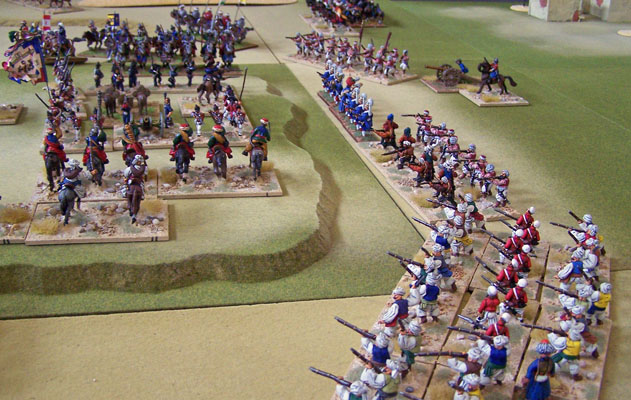|
Napoleon in Egypt
This was our 2008 display games theme. We picked three battles at three different shows Wappinshaw 2008 Battle of the Pyramids 1798 Background In 1798 Napoleon Bonaparte persuaded the ruling Directory of France to invade Egypt. In truth the Directory were pleased to see the famous young General go. Napoleon’s successful Italian campaign had made him a popular figure in revolutionary France, a potential threat to the rule of the Directory. Napoleon sailed from Toulon on 19 June 1798 with a French fleet commanded by Admiral Brueys of nearly 100 warships and 400 transports. He commanded an army of 35,000 men organised into five infantry and one cavalry divisions. The expedition also included a large number of scientists and artists (Savants) whose task it was to modernise this new French colony. After evading the British fleet they arrived in Malta on 6 June and after some limited resistance the Knights of Malta capitulated on 11 June. After securing the island and raiding the Treasury the fleet moved on to its final destination, Egypt. In 1798 Egypt was nominally part of the Ottoman Empire and ruled by a puppet Pasha representing the Ottoman Sultan Selim III. In practice it was ruled by the Mamelukes, warrior slaves mostly originating from the Caucasus region commanded by Murad Bey. Campaigns in Egypt Napoleon landed near Alexandria on 1 July. The city capitulated two days later after a short fight and Napoleon immediately began the advance towards Cairo. The logistical preparations for the advance were poor with little transport or even horses for the cavalry. The first skirmish happened at Shubra Khit on 13 July. The French army fought in divisional squares with artillery at the corners. Disciplined fire drove off the Mamelukes supported by a small flotilla of gunboats. The French then advanced soutwards but were so exhausted they had to rest for two days. Battle of the Pyramids This was the first major battle of the campaign and took place four miles from Cairo within sight (just!) of the Pyramids on 21 July. Napoleon ordered an advance on the Mameluke army led by Murad Bey with each of the five divisions of his army organized into hollow rectangles with cavalry and baggage at the center and cannon at the corners. The French divisions advanced south in echelon, with the right flank leading and the left flank protected by the Nile. From right to left, Napoleon posted the divisions of Desaix, Reynier, Dugua, Vial and Bon. In addition, Desaix sent a small detachment to occupy the nearby village of Biktil, just to the west. Murad anchored his right flank on the Nile at the village of Embabeh, which was fortified and held with infantry and some artillery. His Mamluk cavalry deployed on the desert flank. Ibrahim Bey, with a second army, watched helplessly from the east bank of the Nile, unable to intervene. (Chandler asserts that Napoleon's 25,000-strong army outnumbered Murad's 6,000 Mamluks and 15,000 infantry.) At about 3:30 pm, the Mamluk cavalry hurled itself at the French. The divisional "squares" of Desaix, Reynier and Dugua held firm and repelled the horsemen with point-blank musket and artillery fire. Unable to make an impression on the French formations, some of the frustrated Mamluks rode off to attack Desaix's detached force. Even this was a failure. Meanwhile, nearer the river, Bon's division deployed into attack columns and charged Embabeh. Breaking into the village, the French routed the garrison. Trapped against the river, many of the Mamluks and infantry tried to swim to safety, but hundreds drowned. Napoleon reported a loss of 29 killed and 260 wounded. Murad's losses were far heavier, perhaps as many as 3,000 of the irreplaceable Mamluk cavalry and unknown numbers of infantry. Murad escaped to Upper Egypt, where he carried on an active guerilla campaign before being run to earth by Desaix in late 1799. For the later battles in the campaign come and see us at Carronade (10 May) and Albanich (5 July) wargame shows. The Armies The French Army of the Orient was organised as the standard revolutionary army with infantry in 15 Demi-Brigades of around 1700 men supported by two regiments of light cavalry and five of Dragoons. Artillery included a siege train, 72 field guns and 24 howitzers. On embarkation the army was equipped in the uniforms of the period but conditions in Egypt soon forced changes. These included a black leather peaked cap for the infantry called the "petits-casquettes" together with lightweight cotton or linen tunics. These changes were confirmed in the Kleber Ordance of 1799 that resulted in a variety of colourful uniforms. Specialist units included the Regiment de Dromedaires and locally raised forces from the Greek and Coptic communities together with some Mamelukes and even Janissaries. The chief opponents of the French were the Mamelukes. These included the flamboyant Mameluke horse, together with local Ottoman forces including Janissaries and Sipahis. They would be supported by Bedouin Arabs from the desert tribes and mobs of fellahin some armed with little more than clubs. Ottoman invasion forces included the usual Sipahis horse and Janissaries together with Albanian and Moroccan infantry. The Wargame The wargame figures in this display game are 28mm figures mostly from the Old Glory and Dixon ranges. Other figures are from Trent Miniatures and a new range from Britannia. The Nile Flotilla is a bit of a challenge, but the ships boat from Redoubt adds an interesting element to the battles around the Nile. The rules are Principles of War. We use the brigade scale in the Napoleonic version for the larger battles such as the Pyramids. For smaller actions each unit becomes a battalion or even a company. Further Reading The two must have titles both for the narrative and Bob Marrion's wonderful colour plates is Charles Grant's two volume Napoleon's Campaign in Egypt. There are a number of useful Ospreys including: Napoleon's Egyptian Campaigns 1798-1801 MAA 79 French Soldier in Egypt 1798 - 1801 Warrior 77 Armies of the Ottoman Empire 1775 - 1820 MAA 314 Also for local uniforms there is Mark Bevis - Tangier to Tehran, a Wargamers Guide to Middle Eastern Armies of the Napoleonic & Pre-Colonial Era 1780-1830 and for the Ottoman army William Johnston’s Crescent Among the Eagles. For a history of the campaign there is the recently published Napoleon in Egypt by Paul Strathern, and for the Syrian campaign, Nathan Schur's Napoleon in the Holy Land. Plus the story of the French officer Captain Moiret in Memoirs of Napoleon's Egyptian Expedition 1798-1801. Phalanx 2008 Battle of Heliopolis 20 March 1800 Background In 1798 Napoleon Bonaparte persuaded the ruling Directory of France to invade Egypt. In truth the Directory were pleased to see the famous young General go. Napoleon’s successful Italian campaign had made him a popular figure in revolutionary France, a potential threat to the rule of the Directory. In 1798 Egypt was nominally part of the Ottoman Empire and ruled by a puppet Pasha representing the Ottoman Sultan Selim III. In practice it was ruled by the Mamelukes, warrior slaves mostly originating from the Caucasus region commanded by Murad Bey. Campaigns in Egypt Napoleon landed near Alexandria on 1 July and immediately began the advance towards Cairo. The first major battle of the campaign took place four miles from Cairo near the Pyramids on 21 July. The Mameluke cavalry hurled itself at the French but the divisional "squares" held firm. Bon's division deployed into attack columns and captured the fortified village of Embabeh. Napoleon reported a loss of 29 killed and 260 wounded and Murad's, perhaps as many as 3,000. Murad escaped to Upper Egypt, where he carried on an active guerilla campaign before being run to earth by Desaix in late 1799. Syrian Campaign Early in 1799 Napoleon decided to invade Syria (included modern day Palestine, Jordan and Isreal) with an army of 13,000 men. The fortress at El Arish was captured on 20 February followed by Jaffa on 7 March and by 17 March the French occupied Haifa. Next stop was Acre defended by the Ottoman governor Ahmed Pasha el-Djezzar (known as the ‘Butcher’) supported by Sir Sidney Smith who improved the natural defences of the city that stood on a peninsular. After partial breaches he organised nine major assaults between 28 March and 10 May 1799 without success. In April the Pasha of Damascus sought to relieve the siege with an army of 30,000 men joined by more than 7,000 mountain men from Nablus and Arab volunteers. General Kleber at Nazareth received intelligence that the Army of Damascus was encamped below Mount Tabor and marched to meet them. Kleber’s division of some 2000 men arrived too late for his planned surprise attack and instead found themselves surrounded. Meanwhile Napoleon judged that Kleber had taken on too much so marched to his relief. Forming into three squares he swept through the Ottoman camp causing panic. At this moment Kleber counterattacked and the Army of Damascus fled. With the failure of the the final assault at Acre and news of a planned invasion of Egypt from Rhodes, Napoleon withdrew from Acre on 14 May. After a grinding march back across the Sinai Desert he arrived back in Cairo on 14 June. The campaign cost the French 4,500 casualties from action or disease. Napoleon Leaves Egypt The Ottomans followed up the Syrian campaign with a landing at Aboukir in July 1799. After defeating the small French garrison they entrenched about 8000 infantry. Napoleon attacked with around 10000 men and after several infantry attacks Murat’s cavalry entered the defences and cut down the garrison. Having heard of the political turmoil in France Napoleon decided to return to France in August 1799 together with Lannes, Marmont and Murat. He left a furious Kleber in command without even meeting him. Kleber is reported to have said “that bastard has left us with his breeches full of shit. We’ll go back to Europe and rub them in his face”. Kleber had no intention of staying in Egypt and following Ottoman landings at Damiette and a invasion from Syria he began negotiations with the British and the Grand Vizier. However, the draft convention was not approved by the governments and the Grand Vizier refused to halt his advance. Battle of Helipolis Having received an insulting note from the British rejecting peace Kelber moved swiftly. He formed up an army of around 10000 men and marched out of Cairo on the morning of 20 March. The French army formed into squares commanded by Friant, Reynier on the Plain of Koubbe near the ruins of ancient Heliopolis. Kleber commanded the cavalry. The Grand Vizier had an army of 40000 men and the Janissaries followed by horsemen attacked the the French squares. The line held and the routing Ottomans were pursued by the French capturing their camp. In the meantime a separate Ottoman force commanded by Nassif Pasha outflanked the French and entered Cairo. After the battle Kleber had to return to Cairo and put down the uprising. He then pacified the country but was assassinated on 14 June. Menou took over command and a British intervention force landed at Aboukir in March 1801. After battles at Mandora, Alexandria and Rahmanieh a convention was negotiated with the remains of the French army quitting Egypt on 14 September 1801. The Armies The French Army of the Orient was organised as the standard revolutionary army with infantry in 15 Demi-Brigades of around 1700 men supported by two regiments of light cavalry and five of Dragoons. Artillery included a siege train, 72 field guns and 24 howitzers. On embarkation the army was equipped in the uniforms of the period but conditions in Egypt soon forced changes. These included a black leather peaked cap for the infantry called the "petits-casquettes" together with lightweight cotton or linen tunics. These changes were confirmed in the Kleber Ordance of 1799 that resulted in a variety of colourful uniforms. Specialist units included the Regiment de Dromedaires and locally raised forces from the Greek and Coptic communities together with some Mamelukes and even Janissaries. The chief opponents of the French were the Mamelukes. These included the flamboyant Mameluke horse, together with local Ottoman forces including Janissaries and Sipahis. They would be supported by Bedouin Arabs from the desert tribes and mobs of fellahin some armed with little more than clubs. Ottoman invasion forces included the usual Sipahis horse and Janissaries together with Albanian and Moroccan infantry. The Wargame The wargame figures in this display game are 28mm figures mostly from the Old Glory and Dixon ranges. Other figures are from Trent Miniatures and a new range from Britannia. The rules are Principles of War. We use the brigade scale in the Napoleonic version for the larger battles such as the Pyramids. For smaller actions each unit becomes a battalion or even a company. Albanich 2008 Battle of Mount Tabor 1799 Background In 1798 Napoleon Bonaparte persuaded the ruling Directory of France to invade Egypt. In truth the Directory were pleased to see the famous young General go. Napoleon’s successful Italian campaign had made him a popular figure in revolutionary France, a potential threat to the rule of the Directory. Napoleon sailed from Toulon on 19 June 1798 with a French fleet commanded by Admiral Brueys of nearly 100 warships and 400 transports. He commanded an army of 35,000 men organised into five infantry and one cavalry divisions. The expedition also included a large number of scientists and artists (Savants) whose task it was to modernise this new French colony. After evading the British fleet they arrived in Malta on 6 June and after some limited resistance the Knights of Malta capitulated on 11 June. After securing the island and raiding the Treasury the fleet moved on to its final destination, Egypt. In 1798 Egypt was nominally part of the Ottoman Empire and ruled by a puppet Pasha representing the Ottoman Sultan Selim III. In practice it was ruled by the Mamelukes, warrior slaves mostly originating from the Caucasus region commanded by Murad Bey. Campaigns in Egypt Napoleon landed near Alexandria on 1 July. The city capitulated two days later after a short fight and Napoleon immediately began the advance towards Cairo. The logistical preparations for the advance were poor with little transport or even horses for the cavalry. The first major battle of the campaign took place four miles from Cairo near the Pyramids on 21 July. The Mameluke cavalry hurled itself at the French but the divisional "squares" held firm and repelled the horsemen with point-blank musket and artillery fire. Bon's division deployed into attack columns and captured the fortified village of Embabeh. Napoleon reported a loss of 29 killed and 260 wounded. Murad's losses were far heavier, perhaps as many as 3,000 of the irreplaceable Mamluk cavalry and unknown numbers of infantry. Murad escaped to Upper Egypt, where he carried on an active guerilla campaign before being run to earth by Desaix in late 1799. Syrian Campaign Early in 1799 Napoleon decided to invade Syria (included modern day Palestine, Jordan and Isreal) to counter an anticipated Ottoman attack on Egypt with an army of 13,000 men. The fortress at El Arish was captured on 20 February followed by Jaffa on 7 March. Several thousand prisoners were executed outside Jaffa. The bubonic plague infested the army at this stage causing great damage to the capacity and morale of the army. On 17 March the French occupied Haifa, however, the next day the British fleet under Sir Sidney Smith captured Napoleon’s siege guns. Next stop was Acre defended by the Ottoman governor Ahmed Pasha el-Djezzar (known as the ‘Butcher’) supported by Sir Sidney Smith who improved the natural defences of the city that stood on a peninsular. With no siege guns Napoleon had to rely on field guns and mines. After partial breaches he organised nine major assaults between 28 March and 10 May 1799 without success. With the failure of the the final assault and news of a planned invasion of Egypt from Rhodes, Napoleon withdrew from Acre on 14 May. After a grinding march back across the Sinai Desert he arrived back in Cairo on 14 June. The campaign cost the French 4,500 casualties from action or disease. Mount Tabor 15/16 April 1799 During the siege of Acre Djezzar appealed for support from the Ottoman governors of Aleppo and Damascus. In April the Pasha of Damascus responded with an army of 30,000 men joined by more than 7,000 mountain men from Nablus and Arab volunteers. Napoleon with his forces committeed to the siege and other garrisons had only a fraction of this number to counter the relief army. One of his columns was commanded by General Kleber who arrived at Nazareth on 15 April. He received intelligence that the Army of Damascus was encamped below Mount Tabor and marched to meet them. Kleber wanted a chance to make a name for himself and advised Napoleon of his plan too late to be refused. Kleber’s division of some 2000 men arrived too late for his planned surprise attack and instead found themselves surrounded by 10,000 infantry and 25,000 cavalry including the Mamelukes who had fled Egypt with Ibrahim Bey. They fiercely resisted attacks on their two squares but the situation was desperate. Meanwhile Napoleon judged that Kleber had taken on too much so marched to his relief. Forming into three squares he swept through the Ottoman camp causing panic. At this moment Kleber counterattacked and the Army of Damascus fled. The Armies The French Army of the Orient was organised as the standard revolutionary army with infantry in 15 Demi-Brigades of around 1700 men supported by two regiments of light cavalry and five of Dragoons. Artillery included a siege train, 72 field guns and 24 howitzers. On embarkation the army was equipped in the uniforms of the period but conditions in Egypt soon forced changes. These included a black leather peaked cap for the infantry called the "petits-casquettes" together with lightweight cotton or linen tunics. These changes were confirmed in the Kleber Ordance of 1799 that resulted in a variety of colourful uniforms. Specialist units included the Regiment de Dromedaires and locally raised forces from the Greek and Coptic communities together with some Mamelukes and even Janissaries. The chief opponents of the French were the Mamelukes. These included the flamboyant Mameluke horse, together with local Ottoman forces including Janissaries and Sipahis. They would be supported by Bedouin Arabs from the desert tribes and mobs of fellahin some armed with little more than clubs. Ottoman invasion forces included the usual Sipahis horse and Janissaries together with Albanian and Moroccan infantry. The Wargame The wargame figures in this display game are 28mm figures mostly from the Old Glory and Dixon ranges. Other figures are from Trent Miniatures and a new range from Britannia. The rules are Principles of War. We use the brigade scale in the Napoleonic version for the larger battles such as the Pyramids. For smaller actions each unit becomes a battalion or even a company. |
|
Proudly powered by Weebly

